Scottish Gold
Introduction
Scottish Gold
14 March – 15 June 2014
Hunterian Art Gallery
Admission £5.00/£3.00
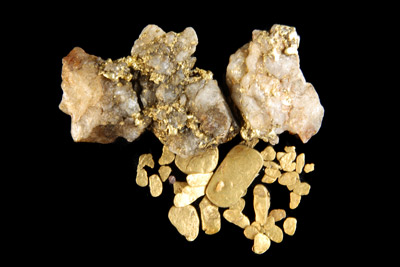 This major new exhibition features a spectacular array of Scottish gold items from the Bronze Age to the present. Focussing on the occurrence of gold in Scotland and Scottish gold mining, Scottish Gold offers a unique opportunity to learn about the precious metal as part of the natural history of Scotland and its historical uses.
This major new exhibition features a spectacular array of Scottish gold items from the Bronze Age to the present. Focussing on the occurrence of gold in Scotland and Scottish gold mining, Scottish Gold offers a unique opportunity to learn about the precious metal as part of the natural history of Scotland and its historical uses.
Drawing on The Hunterian’s rich collections of mineralogy, archaeology and history and supported by key loans from around the UK, Scottish Gold features a large selection of the finest Scottish gold specimens and objects made and used in Scotland.
For the first time, several of the largest known Scottish gold nuggets are displayed together and the surviving gold torcs from the large hoard found at Law Farm, Moray, in 1857 have been reunited. Other key objects include a gold chain and badge of Order of the Thistle, Scottish gold coinage and medals, and superb racing cups.
Image: Gold flakes and masses of gold in quartz © The Hunterian, University of Glasgow 2014.
Natural History
Natural History
Gold is a noble metal. Shining, beautiful, alluring and as old as the universe, it is all around us. Gold is present in minute quantities all over the earth, in sea water, in animals and even in humans.
 Nuggets and flakes of gold are found widely in river deposits, washed out from the parent rock. Only in the few places on Earth, where gold appears in a more concentrated form, notably California, South Africa and Australia, can it be extracted and refined in any quantity. Even Scotland has its own deposits, including Leadhills in Lanarkshire, where the metal has long been mined and panned.
Nuggets and flakes of gold are found widely in river deposits, washed out from the parent rock. Only in the few places on Earth, where gold appears in a more concentrated form, notably California, South Africa and Australia, can it be extracted and refined in any quantity. Even Scotland has its own deposits, including Leadhills in Lanarkshire, where the metal has long been mined and panned.
Mankind first exploited gold more than 6000 years ago. It was in use in Scotland before the end of the third millennium BC and from the late first millennium BC gold was turned into coin both to store and transfer wealth. The malleability of gold allows it to be wrought into a great variety of objects from royal crowns to simple wedding rings.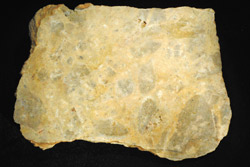
The many other useful properties of gold include its softness, conductivity, inertness and solubility. Gold plays a frequent and important role in decoration, electronics, communications and medicine. Since we first started to use gold, its appearance on a table, in costume and jewellery, on buildings and sculptures has enabled a monarch, an institution, a community or a person to demonstrate both wealth and prestige.
Images:
Map of Scotland with the main locations from which gold has been obtained (red stars) with the major geological fault zones (grey lines) © The Hunterian, University of Glasgow 2014.
Sutherland breccia that contains up to 12g per tonne of gold © The Hunterian, University of Glasgow 2014.
Treasures from Scotland
Gold Treasures from Scotland
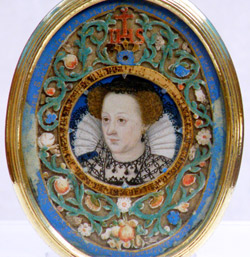 Scottish Gold features a range of intriguing objects made for an increasing number of purposes and relating to specific events or people throughout Scottish history.
Scottish Gold features a range of intriguing objects made for an increasing number of purposes and relating to specific events or people throughout Scottish history.
The exhibition begins with prehistoric ornaments, including beautiful gold lunulae, torcs and penannular bracelets. Roman and Viking items feature gold coins and jewellery and include a stunning crossbow fibula found in Moray.
Golden treasures associated with Robert the Bruce, Mary Queen of Scots, Charles I, James VI and Queen Victoria tell the story of Scotland’s economy, politics and society.
In the 21st century, the medieval mace of the University of Glasgow remains in use on great occasions. 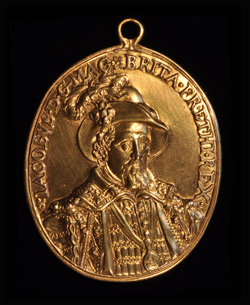 Another mark of authority, the collar of the Deacon of the Incorporation of Goldsmiths of Edinburgh, is itself a reminder of the living heritage of gold in modern Scotland.
Another mark of authority, the collar of the Deacon of the Incorporation of Goldsmiths of Edinburgh, is itself a reminder of the living heritage of gold in modern Scotland.
Images:
Gold and enamel miniature reliquary © Blairs College.
James VI and I portrait badge, c.1620 © The Hunterian, University of Glasgow 2014.
Must See Items
Must See Items
Below is a selection of some of the most fascinating tems on display in the Scottish Gold exhibition.
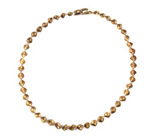 Law Farm Hoard
Law Farm Hoard
This gold ribbon torc is part of the hoard discovered in 1857 on Law Farm, Moray. At least 36 torcs were found under a cairn of rocks by a ploughman and although some are thought to have been lost or destroyed, a number are now in museums around the UK. Considered to be the largest hoard of prehistoric gold ever found in Scotland, they have been reunited in the Scottish Gold exhibition for the first time in over 150 years.
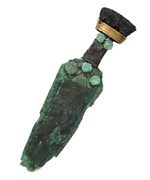 Forteviot Dagger
Forteviot Dagger
This recent find dates to the Early Bronze Age and was found on a recent major excavation carried out by the University of Glasgow. The dagger is crafted from a variety of materials but its gold decoration is one of earliest uses of gold in Scotland. Dated somewhere between 2100 BC and 1950 BC, it was found in a burial site that had survived in a remarkable state of preservation.
James V 'Bonnet Piece'
The gold ducat of James V is considered to be one of the most magnificent of Scottish coins. Made of gold from Crawford Moor, the ducat or ‘bonnet piece’ bears a splendid portrait of the monarch wearing a bejewelled bonnet. 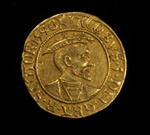 It is particularly noteworthy as it was the first gold coin to bear an actual date - 1539.
It is particularly noteworthy as it was the first gold coin to bear an actual date - 1539.
Ampulla
Although Charles I ascended the throne of Great Britain in 1625, two coronations were required. The King’s Scottish Coronation did not take place until 1633, when he finally travelled to Scotland. The ceremony took place in the refurbished abbey church at Holyrood and this small ampulla, a unique gold vessel, contained the sacred oil used to anoint him.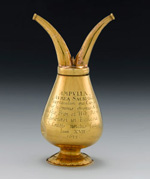
Images:
Iron Age gold torc from the Law Farm hoard © The Hunterian, University of Glasgow 2014.
Dagger from Forteviot, Perth and Kinross © 2013 Andy Holland.
James V ducat or bonnet piece, 1540 ©The Hunterian, University of Glasgow 2014.
Ampulla used at the Scottish Coronation of Charles I, 1633 © National Museums Scotland.
Further Information
Further Information
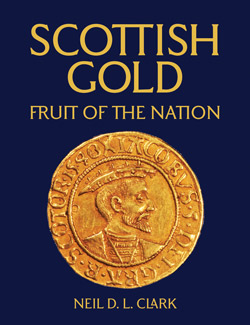 Scottish Gold by Dr Neil Clark
Scottish Gold by Dr Neil Clark
Published to accompany the Scottish Gold exhibition and available at a special discounted price to all exhibition ticket holders. This book is the first to chart the intriguing story of gold in Scotland and includes its remarkable uses from prehistoric times to the present day. (RRP £14.99).
Events
Events
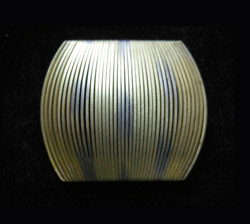 Scottish Gold will be accompanied by a varied events programme including exhibition tours, a one day symposium, various workshops, gold panning demonstrations and a gold panning expedition to Leadhills. A special series of lunchtime talks will take place every Wednesday for the duration of the exhibition, featuring fascinating gold-related topics.
Scottish Gold will be accompanied by a varied events programme including exhibition tours, a one day symposium, various workshops, gold panning demonstrations and a gold panning expedition to Leadhills. A special series of lunchtime talks will take place every Wednesday for the duration of the exhibition, featuring fascinating gold-related topics.
Scottish Gold Tours
Daily (excluding Mondays) from 22 March 2014
3.15pm
Hunterian Art Gallery
Scottish Gold daily tours let by our student MUSEs.
Tours last approximately 30 minutes and are included in the exhibition ticket price (£5.00/£3.00 concession).
Centre for Open Studies Scottish Gold Course
Saturday 8 March 2014
10.00am - 1.00pm
This half-day course is based on the Scottish Gold exhibition. Covering the exhibition themes, the course will look in more detail at various aspects of gold in Scotland, including the geology of gold, its occurrence in Scotland, the history of mining, working and using gold in Scotland from archaeological pre-history, to the present day, and its role in Scottish history and culture.
Programme details:
10.00 Introduction
10.15 Dr. John Faithfull, Curator of Mineralogy, The Hunterian - The Natural History of Gold
11.00 Dr Alison Sheridan, Principal Curator of Early Prehistory, National Museums of Scotland - Scottish Archaeological Gold
11.30 Coffee (and the chance to look at a range of gold-related geological and other specimens)
12.00 Dr Neil Clark, Curator of Palaeontology, The Hunterian - The Scottish Gold Rushes
12.30 Dr John Faithfull - Finding and Mining Gold
1.00pm - Finish.
Course number 19051. For further information, or to book visit:
http://www.gla.ac.uk/services/centreforopenstudies/howtoenrol/
Scottish Gold Lunchtime Talks
Every Wednesday
12.45pm - 1.00pm
Hunterian Art Gallery
Admission free (includes entry to the exhibition)
Wednesday 26 March
The gold rushes of Scotland
Dr Neil Clark, Curator of Palaeontology, The Hunterian
Wednesday 2 April
Bronze Age Bling
Alison Sheridan, Principal Curator of Early Prehistory, National Museums of Scotland
Wednesday 9 April
Where does gold come from?
Dr John Faithfull, Curator of Mineralogy, The Hunterian
Wednesday 16 April
The University’s 1460s mace
Professor David Gaimster, Director, The Hunterian
Wednesday 23 April
The Scottish Coronation of 1633
Dr Donal Bateson, Senior Curator, The Hunterian
Wednesday 30 April
Drawing in Gold
Andrew Lamb, Lecturer, Silversmithing and Jewellery, The Glasgow School of Art
Wednesday 7 May
Gold in Medicine
Stuart McDonald, Senior Lecturer, Anatomy, University of Glasgow
Wednesday 14 May
The Incorporation of Goldsmiths of the City of Edinburgh
Sarah McAdam, Incorporation Manager, The Incorporation of Goldsmiths of the City of Edinburgh
Wednesday 21 May
Title to be confirmed
Adrian Boyce, Professor of Applied Geology, SUERT, University of Glasgow
Wednesday 28 May
Going for gold – contemporary jewellery
Elizabeth Moignard, Honorary Professorial Research Fellow, Classics, University of Glasgow
Wednesday 4 June
Strathearn Environs and Royal Forteviot Project
Steve Driscoll, Professor of Historical Geography, Archaeology, University of Glasgow
Perspectives in Gold
4 April – 4 May 2014
Hunterian Art Gallery
Admission free
This special display features new work using gold by students from Scottish colleges, sponsored by The Scottish Goldsmiths’ Trust Precious Metal Bursary 2014.
The Scottish Goldsmiths Trust is a charity set up in 2000 by the Incorporation of Goldsmiths of Edinburgh to promote and support the education, art and craft of Scotland’s gold and silversmithing heritage. The Trust assists practicing gold and silversmiths and students of silversmithing and jewellery through both Trust-led projects and grants.
The trust gives annual Precious Metal Grants to five Scottish colleges with jewellery and silversmithing courses: City of Glasgow College, Edinburgh College of Art, Duncan of Jordanstone College of Art and Design, Glasgow Clyde College and The Glasgow School of Art. The grant gives students the opportunity to work and experiment with silver and gold, developing their skills and knowledge in working with these precious materials.
To celebrate the exhibition Scottish Gold, the Scottish Goldsmiths Trust is delighted to have partnered The Hunterian to present this showcase of the work that can be produced through the Precious Metal Bursaries.
Perspectives in Gold Symposium
Saturday 5 April 2014
9.30am – 4.30pm
Hunterian Art Gallery
This symposium has been organised by Scottish Goldsmiths’ Trust in collaboration with The Hunterian and coincides with the Scottish Gold exhibition and a display of works by students from the Scottish Colleges of Art resulting from The Scottish Goldsmiths’ Trust Precious Metal Bursary 2014.
9.30am – 10.00am Coffee & Registration
10.15am – 10.30am Welcome (Sarah McAdam, SGT and Professor David Gaimster, Hunterian)
10.30am – 11.10am George Dalgleish, A History of Scottish Gold
11.15am - 11.55am Peter Davidson, A Mineralogical/Geological Perspective
12.00pm – 12.25pm Misun Won – Keum Boo in Contemporary Jewellery
12.30pm – 2.30pm Lunch; Keum Boo Demonstrations (City of Glasgow College); Exhibition Visits
2.30pm – 3.10pm Andrew Lamb
3.10pm – 3.35pm Filipa Oliveira – Filum Granum in the Life of a Jeweller
3.40pm – 4.15pm Panel Discussion – Scottish Gold; The Future
4.15pm – 4.30pm Summary/Thanks
This symposium is aimed at students and emerging jewellers/silversmiths. To book visit http://www.eventbrite.co.uk/e/scottish-gold-symposium-tickets-10888881939
For further information email info@incorporationofgoldsmiths.org or telephone 0131 557 6938.
Visits to the Cononish Gold Mine, Tyndrum
Friday 9 May and Friday 6 June 2014
9.00am - 4.00pm
£15.00 per head (limited to 15 people)
These special visits offer a rare chance to visit Scotland’s prospective gold mine and the opportunity to see the gold-bearing rocks underground and on the surface.
Led by Chris Sangster, CEO Scotgold Resources Ltd and Dr John Faithfull, Curator of Mineralogy at The Hunterian, University of Glasgow, each trip will look at the geology of the gold deposit, and at the practical, technical and environmental issues involved in developing a gold mine.
Each visit is limited to 15 people. Part of the excursion will be on the surface, and may be exposed to rain or other bad weather, so you should be suitably dressed and equipped. Safety boots, lamps and hard hats for the underground part of the visit will be provided by Scotgold.
Participants must be over 18 years old.
The visit is not suitable for anybody with mobility difficulties, as it will involve around 2km of walking on a rough track.
Minibus departs from the University of Glasgow at 9.00am on both days. Bring a pack lunch. The bus should be back at the University by 4.00pm at the latest.
For further details and booking, contact john.faithfull@glasgow.ac.uk, or phone 0141 330 4213.
Gold Panning Workshops
Saturday 7 June 2014
12.00pm - 2.00pm
Hunterian Art Gallery
A 30-minute introduction to the tricks and techniques for gold panning! Sessions run every half hour between 12.00pm and 2.00pm. Suitable for all ages.
Please note that sessions take place in the Hunterian Art Gallery and outdoors - please wear weather appropriate clothes.
Free drop-in activities for all the family - no booking required.
Gold Panning Field Trip to Wanlockhead
Suitable CPD for teachers for CfE and Outdoor Learning
Friday 16 May 2014
9.00am - 4.15pm
Programme details:
9.00am Meet at Hunterian Art Gallery, minibus departs Glasgow
10.30am – 12.00pm Arrive at Wanlockhead, visit to Hidden Treasures Museum and lead mine
12.00pm - 12.45pm Lunch
12.45pm - 2.00pm Panning for gold with expert and Hunterian curator Dr Neil Clark
2.00pm Depart from Wanlochead
3.30pm Arrive at Glasgow, tour of Scottish Gold exhibition, Hunterian Art Gallery
4.15pm End
£100 per person. Booking essential - email Monica.Callaghan@glasgow.ac.uk
Cost includes: expert guide; travel; lunch; Gold panning licence; materials; entry into the mine, the Hidden Treasures Museum and the Scottish Gold exhibition; copy of Scottish Gold book by Dr Neil Clark.
Image: Feather brooch by Andrew Lamb, 2000. Photo courtesy of Professor E Moignard.

